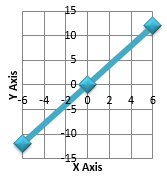Match the following columns:
Column I | Column II |
A. The equation of a line parallel to x-axis is | (p) y = mx |
B. The equation of a line parallel to y-axis is | (q) |
C. The equation of a line through the origin is | (r) x = k |
D. If the point (2, 3) lies on the graph of the equation 3y = ax + 4, then a = | (s) y = k |
Column I | Column II |
A. The equation of a line parallel to x-axis is | (s) y = k |
B. The equation of a line parallel to y-axis is | (r) x = k |
C. The equation of a line through the origin is | (p) y = mx |
D. If the point (2, 3) lies on the graph of the equation 3y = ax + 4, then a = | (q) |
A. We know that the equation of x-axis is y = 0 and the equation of any line parallel to x axis is y = k, where k is any constant.
B. We know that the equation of y-axis is x = 0 and the equation of any line parallel to y axis is x = k, where k is any constant.

C. For, y = mx
If we put x = 0 then, y = m×0 = 0 therefore, we get (0, 0) which is origin. So, y = mx represents a line passing through the origin.
The blue line is the graph of y = mx which clearly, passes through origin.
D. Given equation, 3y = ax + 4
⇒ ax = 3y – 4
![]()
Point (2,3) i.e. x = 2 and y = 3
![]()
![]()
![]()
